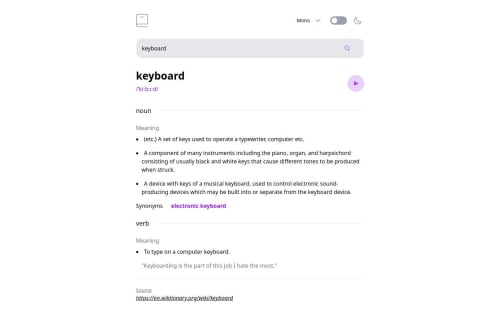Dictionary Web app React JS + tailwind

Solution retrospective
First time using Tailwind and API. Tailwind was a bit confusing at the start when trying to sort page responsiveness on different screens but really enjoyed using it as it allows you to style elements as you create them easier, once you can remember the tailwind value.... Also will look into what is the best way to implement a dark mode, i have seen a few different ways online. I started using ${isDarkMode} and then discovered "dark:" on tailwind docs, but stuck with ${isDarkMode} conditionally rendering classes.
What challenges did you encounter, and how did you overcome them?An annoying issue was the drop down box to select the fonts. I had originally used a Select tag with 3 option tags as it was quickest but styling the drop down box of options became very difficult with tailwind. So i re-wrote it and used .map()function to generate the box which allowed me to easily put a box shadow around it for dark mode.
What specific areas of your project would you like help with?As i said above if anyone has any suggestions what is the best way to implement a dark mode with tailwind in react please let me know or even link to a favorite doc or video showcasing it, thanks .
Please log in to post a comment
Log in with GitHubCommunity feedback
No feedback yet. Be the first to give feedback on conormcfarlane's solution.
Join our Discord community
Join thousands of Frontend Mentor community members taking the challenges, sharing resources, helping each other, and chatting about all things front-end!
Join our Discord